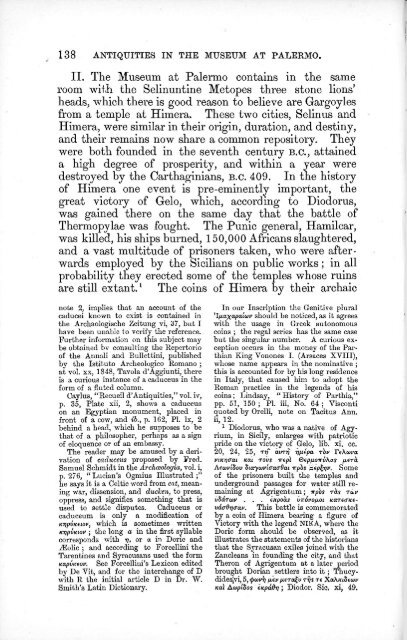Sicily presents to the ordinary tourist attractions which in number ...
Sicily presents to the ordinary tourist attractions which in number ...
Sicily presents to the ordinary tourist attractions which in number ...
Create successful ePaper yourself
Turn your PDF publications into a flip-book with our unique Google optimized e-Paper software.
138 ANTIQUITIES IN THE MUSEUM AT PALERMO.<br />
II. The Museum at Palermo conta<strong>in</strong>s <strong>in</strong> <strong>the</strong> same<br />
room with <strong>the</strong> Sel<strong>in</strong>unt<strong>in</strong>e Me<strong>to</strong>pes three s<strong>to</strong>ne lions'<br />
heads, <strong>which</strong> <strong>the</strong>re is good reason <strong>to</strong> believe are Gargoyles<br />
from a temple at Himera. These two cities, Sel<strong>in</strong>us and<br />
Himera, were similar <strong>in</strong> <strong>the</strong>ir orig<strong>in</strong>, duration, and dest<strong>in</strong>y,<br />
and <strong>the</strong>ir rema<strong>in</strong>s now share a common reposi<strong>to</strong>ry. They<br />
were both founded <strong>in</strong> <strong>the</strong> seventh century B.C., atta<strong>in</strong>ed<br />
a high degree of prosperity, and with<strong>in</strong> a year were<br />
destroyed by <strong>the</strong> Carthag<strong>in</strong>ians, B.C. 409. In <strong>the</strong> his<strong>to</strong>ry<br />
of Himera one event is pre-em<strong>in</strong>ently important, <strong>the</strong><br />
great vic<strong>to</strong>ry of Gelo, <strong>which</strong>, accord<strong>in</strong>g <strong>to</strong> Diodorus,<br />
was ga<strong>in</strong>ed <strong>the</strong>re on <strong>the</strong> same day that <strong>the</strong> battle of<br />
Thermopylae was fought. The Punic general, Hamilcar,<br />
was killed, his ships burned, 150,000 Africans slaughtered,<br />
and a vast multitude of prisoners taken, who were afterwards<br />
employed by <strong>the</strong> Sicilians on public works; <strong>in</strong> all<br />
probability <strong>the</strong>y erected some of <strong>the</strong> temples whose ru<strong>in</strong>s<br />
are still extant. 1 The co<strong>in</strong>s of Himera by <strong>the</strong>ir archaic<br />
note 2, implies that an account of <strong>the</strong><br />
caducei known <strong>to</strong> exist is conta<strong>in</strong>ed <strong>in</strong><br />
<strong>the</strong> Archaologische Zeitung vi, 37, but I<br />
have been unable <strong>to</strong> verify <strong>the</strong> reference.<br />
Fur<strong>the</strong>r <strong>in</strong>formation on this subject may<br />
be obta<strong>in</strong>ed consult<strong>in</strong>g <strong>the</strong> Reper<strong>to</strong>rio<br />
of <strong>the</strong> Aunali and Bullett<strong>in</strong>i, published<br />
by <strong>the</strong> Istitu<strong>to</strong> Areheologico Romano ;<br />
at vol. xx, 1848, Tavola d'Aggiunti, <strong>the</strong>re<br />
is a curious <strong>in</strong>stance of a caduceus <strong>in</strong> <strong>the</strong><br />
form of a fluted column.<br />
Caylus, "Reeueil d'Antiquities," vol. iv,<br />
p. 35, Plate xii, 2, shows a caduceus<br />
on an Egyptian monument, placed <strong>in</strong><br />
front of a cow, and ib., p. 162, PI. Ix, 2<br />
beh<strong>in</strong>d a head, <strong>which</strong> he supposes <strong>to</strong> be<br />
that of a philosopher, perhaps as a sign<br />
of eloquence or of an embassy.<br />
The reader may be amused by a derivation<br />
of caduceus proposed by Fred.<br />
Samuel Schmidt <strong>in</strong> <strong>the</strong> Archceologia, vol. i,<br />
p. 276, " Lucian's Ogmius Illustrated ;"<br />
he says it is a Celtic word from cat, mean<strong>in</strong>g<br />
war, dissension, and ducken, <strong>to</strong> press,<br />
oppress, and signifies someth<strong>in</strong>g that is<br />
used <strong>to</strong> settle disputes. Caduceus or<br />
caduceum is only a modification of<br />
κηρύκειορ, <strong>which</strong> is sometimes written<br />
κηρύκιον ; <strong>the</strong> long a <strong>in</strong> <strong>the</strong> first syllable<br />
corresponds with 17, or a <strong>in</strong> Doric and<br />
iEolic ; and accord<strong>in</strong>g <strong>to</strong> Foreell<strong>in</strong>i <strong>the</strong><br />
Tarent<strong>in</strong>es and Syracusans used <strong>the</strong> form<br />
καρύκεον. See Forcell<strong>in</strong>i's Lexicon edited<br />
by De Vit, and for <strong>the</strong> <strong>in</strong>terchange of D<br />
with R <strong>the</strong> <strong>in</strong>itial article D <strong>in</strong> Dr. W.<br />
Smith's Lat<strong>in</strong> Dictionary.<br />
In our Inscription <strong>the</strong> Genitive plural<br />
Ίμαχαραίων should be noticed, as it agrees<br />
with <strong>the</strong> usage <strong>in</strong> Greek au<strong>to</strong>nomous<br />
co<strong>in</strong>s ; <strong>the</strong> regal series has <strong>the</strong> same case<br />
but <strong>the</strong> s<strong>in</strong>gular <strong>number</strong>. A curious exception<br />
occurs <strong>in</strong> <strong>the</strong> money of <strong>the</strong> Parthian<br />
K<strong>in</strong>g Vonones I. (Arsaces XVIII),<br />
whose name appears <strong>in</strong> <strong>the</strong> nom<strong>in</strong>ative ;<br />
this is accounted for by his long residence<br />
<strong>in</strong> Italy, that caused him <strong>to</strong> adopt <strong>the</strong><br />
Roman practice <strong>in</strong> <strong>the</strong> legends of his<br />
co<strong>in</strong>s; L<strong>in</strong>dsay, " His<strong>to</strong>ry of Parthia,"<br />
pp. 51, 150 ; PI. iii, No. 64 ; Visconti<br />
quoted by Orelli, note on Tacitus Ann.<br />
ii, 12.<br />
1 Diodorus, who was a native of Agyrium,<br />
<strong>in</strong> <strong>Sicily</strong>, enlarges with patriotic<br />
pride on <strong>the</strong> vic<strong>to</strong>ry of Gelo, lib. xi, cc.<br />
20, 24, 25, Trf a<strong>in</strong>rj ημέρα rbi> Τε\ωνα<br />
νικησαι και <strong>to</strong>vs ττερϊ Θερμοπύλας μετά<br />
Λεωνίδου διαγωνίσασθαι Trpbs αερξην. Some<br />
of <strong>the</strong> prisoners built <strong>the</strong> temples and<br />
underground passages for water still rema<strong>in</strong><strong>in</strong>g<br />
at Agrigentum; νpbs rbs των<br />
υδάτων . . . εκροάς υπόνομοι κατασκευάσθηκαν.<br />
This battle is commemorated<br />
by a co<strong>in</strong> of Himera bear<strong>in</strong>g a figure of<br />
Vic<strong>to</strong>ry with <strong>the</strong> legend ΝΙΚΑ, where <strong>the</strong><br />
Doric form should be observed, as it<br />
illustrates <strong>the</strong> statements of <strong>the</strong> his<strong>to</strong>rians<br />
that <strong>the</strong> Syracusan exiles jo<strong>in</strong>ed with <strong>the</strong><br />
Zancleans iu found<strong>in</strong>g <strong>the</strong> city, and that<br />
Theron of Agrigentum at a later period<br />
brought Dorian settlers <strong>in</strong><strong>to</strong> it; Thucydidesjvi,<br />
5, φωνή μεν μεταξύ τi)s τε Χαλκιδεων<br />
καϊ Δωρίδος εκράθη; Diodor, Sic. xi, 49.

















